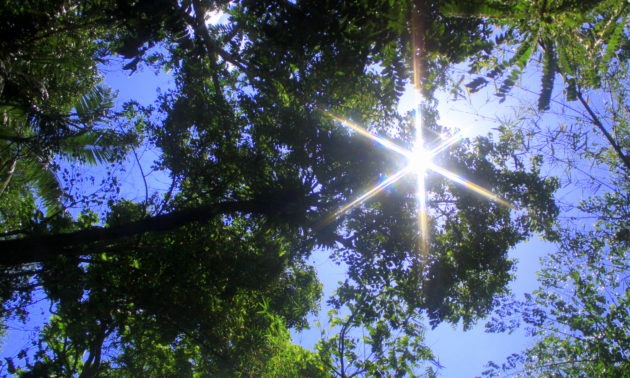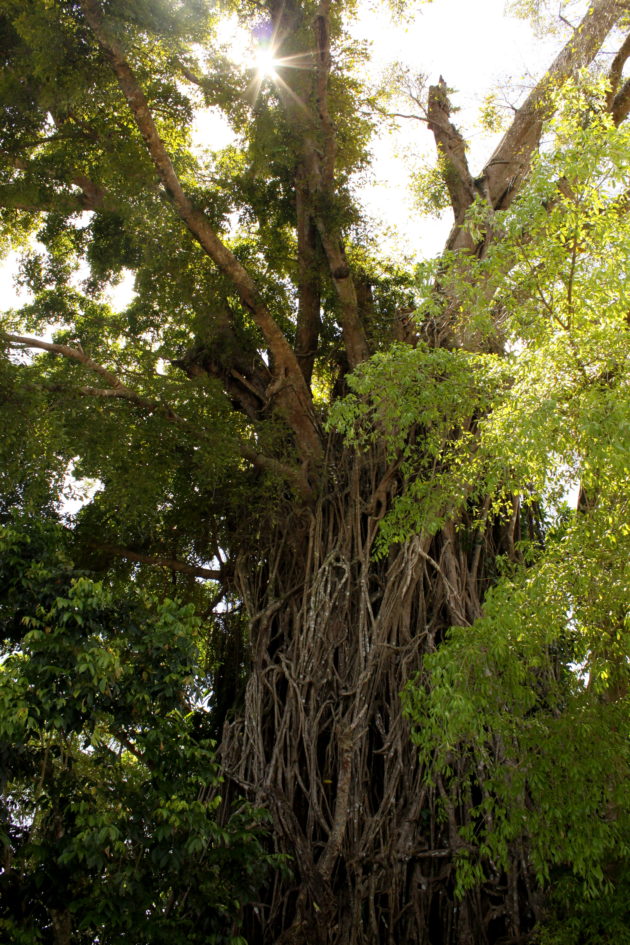
When I was six, I developed a grass-like skin disease around my neck after my family and I visited a hilly area in Tagaytay. My grandfather, Tatay Marcial, who believed it was a punishment from a naughty dwende (elf), warned me against expressing my admiration for plants, especially those that grow in the wild. He admonished, “You shouldn’t have said you liked the grass out loud. The dwende could hear you.”
Well, I had the skin disease for more than a week. I must have looked like the child of an alien, with my head resting on my very green neck. The dermatologist couldn’t diagnose it, so much so that my father, upon Tatay Marcial’s suggestion, resorted to sending for the albulario (folk healer) direct from Quezon Province. Giser, the albulario, said that indeed the culprit was a dwende. He performed some ritual, one that involved applying some gooey substance on my neck and intoning words that sounded like gibberish. I got well after a few days.
That was my weird encounter with vegetation. It was supposed to have given me a trauma, but it did not. I grew up admiring nature. I loved the grass, the flowers, the shrubs, especially the trees. Yes, the trees.
I had a swing in my grandparents’ yard in the barrio when I was a child. It had a wooden seat supported by ropes tied to the branches of two santol (cotton fruit) trees. Tatay Marcial had constructed it with his own hands, and I was grateful to him. But I was grateful to the santol trees, too, for it was their branches that held the swing in place. It was a bad thing I couldn’t say “thank you” to them for fear that an imp would make the yellow-orange fruit grow around my neck. So I just thanked the pair by smiling at them every time I used the swing.
In the barrio, fruit trees guarded my grandparents’ nipa hut in a disorganized semicircle. My little brother and I stayed there one summer break when we were children. I was quite fascinated with the guyabano (soursop), sampalok (tamarind), santol, mango, and lipote trees that grew there. I was startled one time when a guyabano fruit dropped with a thud on the roof, rolled down, and slightly brushed my small head. It cracked open when it hit the ground, exposing its ripe flesh, ready to be eaten. Nanay Lucing, my grandmother, said I was lucky. It wasn’t clear whether she meant I was lucky because it missed my head, or I was lucky because I had an instant dessert. But I thought it was generous of the tree to have offered me its fruit without my asking for it.
There was this tree in that yard that bore globular, dark-purple fruit called lipote. It had a sweet sour taste that my brother and I liked. We watched how Tatay Marcial picked lipote using a fruit picker, which consisted of a thin bamboo pole with a piece of wire fashioned into a hook at one end. He would tug down on the fruit and the stem would snap. We would try to catch the fruit with a plastic bowl like it was a game, which we thought was cool. Nanay Lucing, sensing that we enjoyed the activity, decreed that if we wanted to eat some more, Tatay Marcial would do the fruit picking, not us. That made the tree almost like the Tree of Knowledge.
But a decree is meant to be disobeyed especially by curious children who think that Don’ts are actually Dos. So one afternoon, when Tatay Marcial was running an errand and Nanay Lucing was having a nap, I took the fruit picker from under the bamboo bench by the window and tiptoed out of the hut with my brother. The lipote tree, which grew behind the hut, looked like a gentle giant waiting for a pair of hobbits to divest him of his treasure. Armed with the fruit picker, my brother and I were able to fill a small bowl to the brim with our loot.
The fruit trees in the barrio made the April breeze smell like fruit salad. The scent of the paho was my favorite. And even if it did not grow among the trees in the yard but further down the field, I would go there with Tatay Marcial to admire the small, mango-like fruit which could be eaten fresh, used as relish, or pickled in brine. The tree had a chubby trunk and a wide, rounded canopy. I read my Nancy Drew book there once—my mind in River Heights, my body under its cozy shade.
Life in the barrio moved at a slower tempo than in the city, which made it easier to appreciate things, even routine. In the morning, I would help Nanay Lucing feed the chickens while my brother helped Tatay Marcial feed the pigs. Then we would assist Tatay Marcial in giving water to the goats, cows, and carabaos in the field; after which, we would play badminton (or whatever games we fancy) until lunchtime.
Tatay Marcial told us stories before we went to bed. There was one about the bulislis, a child-eating creature with a mouth so big that every time it laughed, its mouth would cover its entire face. There was another about seven children who managed to escape the witch’s wrath using magic boots. I suspected that when Tatay Marcial narrated his stories, my brother and I were not the only ones listening but the trees as well. And that they vowed they would protect us from creatures such as the witch and the bulislis.

My fascination with trees did not stop in the barrio. In the town, where my grandparents owned a house big enough to hold ballroom dances, it was the jackfruit tree that piqued my interest. It crouched on the left side of the house near the well, like a thief carrying sacks of money. Nanay Lucing explained to me that the jackfruit had to be wrapped in sackcloth to ward off insects that couldn’t resist its sweet smell. There was the kalamias tree which was within arm’s reach from the capiz window (window made from bivalve shells of molluscs) of their living room on the second floor. Its fruit was crunchy, juicy and sour; and shaped like a mini cucumber with shiny, yellow-green skin. Nanay Lucing would cook sinigang (sour broth) using freshly picked kalamias, which made the broth nutritious and appetizing. The papaya for tinola (chicken soup) and ginataang manok (a chicken dish cooked in coconut milk) came from the papaya tree in the backyard. And the coconut trees provided the gata for the various ginataan dishes.
I was a skinny girl, so Tatay Marcial would boil a small piece of bark from a mystery tree (read: I had no idea which tree the bark came from) and let me drink its woodsy, bitter, blackish broth like it was a witch’s potion that could transform my body into the ideal size in one gulp. My brother, who appeared to be robust, was never made to drink it. I always felt energized, though, after drinking the broth, and so believed in its medicinal powers.
In Manila, where I have spent most of my life, trees become decorative pieces. They are planted to line roads, beautify parks and universities, border houses and buildings. They are strategically placed to break the monotony of concrete and squarish structures. Viewed from a helicopter, they probably look like patches of green in a city that is predominantly gray.
But anyone who has climbed up a tree or hugged one knows that trees are not mere ornaments. They are our friends. There used to be an aratiles tree in front of our house that bore sweet, spherical fruit smaller than the cherry. Children in my neighborhood did not like this fruit and poked fun at it. They said it was lizard’s food. I guess it was the size they were not impressed with. They plucked its fruit, yes, but only to hurl it to other children or reduce it to pulp with a rock. Indeed, there are villainous children as there are villainous adults.
I liked the aratiles tree, though, because of its peculiarities. It had dainty twigs and oblong leaves, which were hairy and sticky and had serrated edges. Its fruit may be small, but it was sweet and replete with tiny seeds. I liked the guava tree as well. I would climb up the tree, sit on its branches like they were protective arms, and partake of its fruit rich in vitamin C. I felt lucky for having that kind of experience. And now, as an adult, I pity people who play online games but have not climbed up a single tree.
The lone pine tree in our street would get the spotlight every December. The wealthy family who owned it loved to bedeck it with colorful parol (paper lanterns), making it their outdoor Christmas tree. It stood elegant and regal on the corner of their lot. When it was toppled by typhoon Reming years ago, it felt like a dear friend had died.

I have never outgrown my admiration for trees. I notice them all the time. I notice them more than people who would do everything just to get noticed. When I want to escape the cacophony around me, I go to a place where there are trees and imbibe their stillness. I once attended an extravaganza-like event. While I have nothing against lively gatherings, the spectacle was too much for me. So I left the venue and found solace under the shade of the nearest tree and, like Buddha, waited for enlightenment. The spot did not remain solely mine for long; soon six or seven guests had joined me, perhaps tree worshipers themselves who opted to get away from all that noise.
I prefer a gathering of trees, like the ones in a park or a rural area, to a gathering of people. Trees do not use up my energy, they recharge it. They do not blabber, they listen. They do not move about, announcing their presence to others. They remain rooted to the ground. I love trees because they do not call attention to themselves. If they do sprout lovely flowers, or shed leaves like confetti, they do so with or without an audience. Surely, they do not need our applause. They certainly do not need fans or followers. Neither do they need the assurance that they belong. They are secure in the knowledge that they are legitimate beings on this planet.
Trees give us oxygen—for free—yet they do not call it their noble mission. They do not consider themselves heroes or do-gooders. They do not go from place to place spreading their name, The Fantastic Trees, like they are candidates in the national elections (eternally present in gatherings, affairs, events); nor do they try to win people’s hearts to merit an award later. In this age of unabashed self-promotion, the trees look glorious in their quietude.
My favorite professor once mentioned in our class a story she had read where a character transformed into a tree when he died. I like the idea of people evolving into something sacred, like a tree.
I went with my family to a resort in the middle of a tropical forest one summer time, and requested that they go for a hike without me. Surrounded by thick foliage, I lay down on the ground, closed my eyes and listened. I was treated by nature to different forest sounds. It was like listening to an orchestra, where the music did not come from string, woodwind, brass and percussion instruments; but from insect vibrations, bird hums, and frog croaks. There was also the faint gurgling sound of the stream, and the rustling of leaves. The tempo was at first fast and lively, then it slowed down, becoming almost lyrical as it gave way to the passage of a soft breeze. Then it picked up again and repeated the same pattern, like the first two movements of a symphony. My spirits soared!
I look up to trees—literally and figuratively. There is a reason they are created taller than us. And, sometimes, when I lose faith in humanity, I like to think it is the tree that is made in God’s image.

Geraldine V. Verzo is an MA creative writing student at the University of Santo Tomas in Manila. She is currently writing her thesis paper, which is a collection of personal essays or short memoirs about her growing up years in her country, the Philippines.
All photos by Ronier V. Verzo.
Advertise in Kyoto Journal! See our print, digital and online advertising rates.
Recipient of the Commissioner’s Award of the Japanese Cultural Affairs Agency 2013